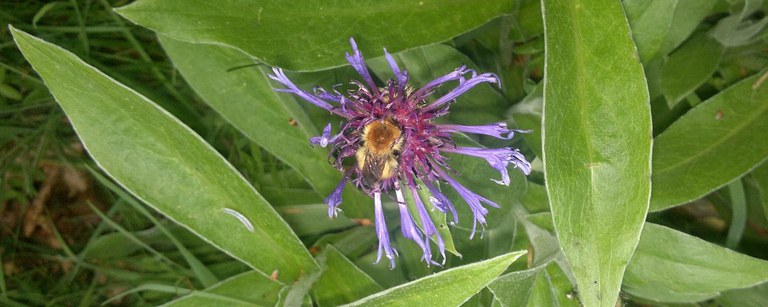I was working outside on the washing green which entailed walking up and down the steps several times during the early evening. I happened to notice that each time I passed the cornflower plant, at the side of the steps, there was a stationary ginger bumblebee perched on top of one of the flowers. The bumblebee was still there more than thirty minutes later in the exact same position, I decided to investigate. I very carefully prodded the bumblebee and it moved in response, so it was still alive.

Moss Carder Bumblebee (Bombus muscorum)
It had been a gloriously warm, sunny day but as evening progressed it clouded over and a brisk East wind took up which meant it felt distinctly chilly. I suspect the bumblebee got caught out with the very rapid temperature change and was unable to fly off. I quickly took a photo using my mobile, shown above, and then left the bumblebee in peace.
Early next morning, before the temperature climbed, the bumblebee was still in the same position. Shortly after breakfast the sun had come out and when I checked the bumblebee had gone. Later that day I continued working on the washing green and on several occasions when I passed I saw what looked like identical ginger bumblebees feasting on the cornflowers. I only ever saw one ginger bumblebee at any one time so it could have been the same one.
Identifying bumblebees isn't easy, partly because some species are very similar to each other and regional variations are common. The other reason is that bumblebees, unlike say flowers, have other things to do than be measured and peered at by humans. By far the most common ginger bumblebee in Scotland is the Common Carder Bumblebee (Bombus pascuorum). The excellent www.bumblebee.org website gives very clear descriptions of the common and not so common species. The website notes that the Common Carder always has some black hairs on the abdomen which I couldn't see on my specimen. That left me with the conclusion that this bumblebee could be a Moss Carder (Bombus muscorum) which is now very rare.
However, after reviewing dozens of online photographs of the Common Carder Bumblebee I am not seeing many with clearly identifiable black hairs. It might be that my specimen is a Common Carder after all.